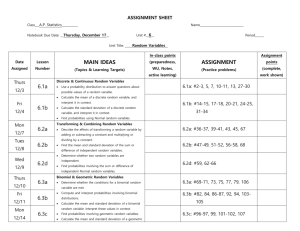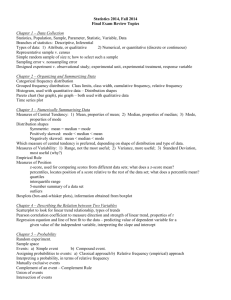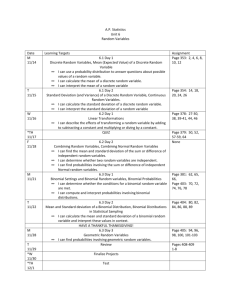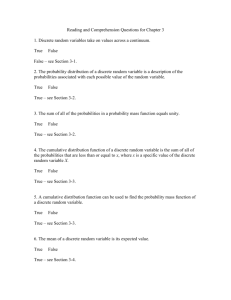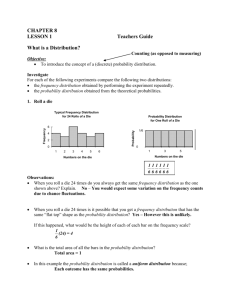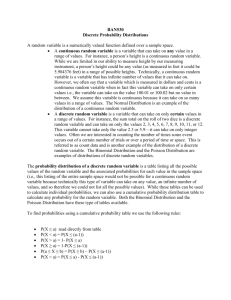Part 2
advertisement
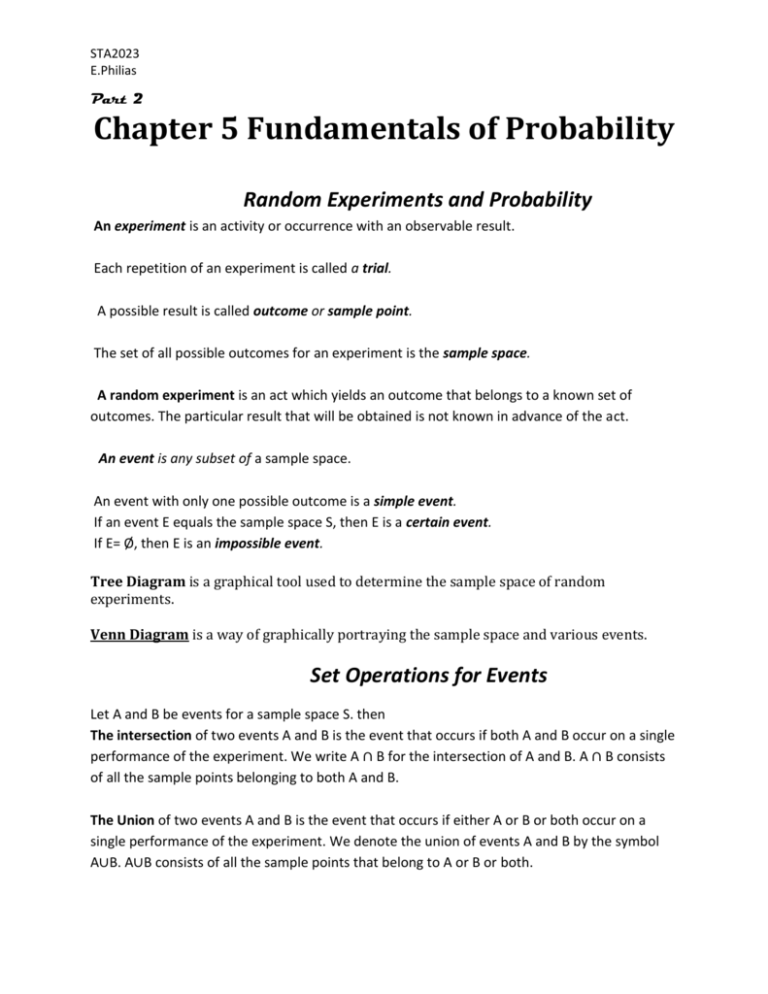
STA2023 E.Philias Part 2 Chapter 5 Fundamentals of Probability Random Experiments and Probability An experiment is an activity or occurrence with an observable result. Each repetition of an experiment is called a trial. A possible result is called outcome or sample point. The set of all possible outcomes for an experiment is the sample space. A random experiment is an act which yields an outcome that belongs to a known set of outcomes. The particular result that will be obtained is not known in advance of the act. An event is any subset of a sample space. An event with only one possible outcome is a simple event. If an event E equals the sample space S, then E is a certain event. If E= Ø, then E is an impossible event. Tree Diagram is a graphical tool used to determine the sample space of random experiments. Venn Diagram is a way of graphically portraying the sample space and various events. Set Operations for Events Let A and B be events for a sample space S. then The intersection of two events A and B is the event that occurs if both A and B occur on a single performance of the experiment. We write A ∩ B for the intersection of A and B. A ∩ B consists of all the sample points belonging to both A and B. The Union of two events A and B is the event that occurs if either A or B or both occur on a single performance of the experiment. We denote the union of events A and B by the symbol A∪B. A∪B consists of all the sample points that belong to A or B or both. STA2023 E.Philias The complement of an event A is the event that occurs when A does not occur. That is, the event consisting of all sample points that are not in event A. We denote the complement of A by A’ or 𝐴𝑐 or 𝐴̅ Mutually Exclusive Events are events that do not share any sample point. Events A and B are disjoint events if AnB = Ø Probability Let S be a sample space of equally likely outcomes, and let event A be a subset of S. The probability of the event A, denoted by P (A), may be expressed as the ratio of the number of elements in A to the total number of elements in the sample space S of the experiment. P (A) = 𝑛𝑢𝑚𝑏𝑒𝑟 𝑜𝑓 𝑒𝑙𝑒𝑚𝑒𝑛𝑡𝑠 𝑖𝑛 𝐴 𝑛𝑢𝑚𝑏𝑒𝑟 𝑜𝑓 𝑒𝑙𝑒𝑚𝑒𝑛𝑡𝑠 𝑖𝑛 𝑆 = 𝑛(𝐴) 𝑛(𝑆) Properties: 1) For any event A, 0 ≤ P (A) ≤ 1 2) If A = Ø, then P (Ø) = 0 3) If A = S, then P (A) = 1 4) P (A’) = 1 – P (A) Addition Rule for Probability For any events A and B from a sample space S, P (A U B) = P (A) + P (B) –P (A n B). Probability of Union of two Mutually Exclusive Events. If A and B are two mutually exclusive events, then: P (A U B) = P (A) + P(B) (AnB = Ø ) STA2023 E.Philias If k events are mutually exclusive, the probability that one of them will occur equals the sum of their respective probabilities. In symbols, P(A1 U A2 U A3 U⋯ U Ak) = P(A1) + P(A2) + P(A3) ⋯ P(Ak) Complement rule For any event A, P(A’) = 1- P(A) and P(A) = 1- P(A’) . Odds The odds of an event E, is a comparison of P (A) with P (A’). 1) The odds in favor of an event A is defined as the ratio of P(A) to P(A’), P(A’) ≠ 0 𝑃(𝐴) 𝑃(𝐴′ ) = 𝑡ℎ𝑒 𝑝𝑟𝑜𝑏𝑎𝑏𝑖𝑙𝑖𝑡𝑦 𝑡ℎ𝑒 𝑒𝑣𝑒𝑛𝑡 𝑤𝑖𝑙𝑙 𝑜𝑐𝑐𝑢𝑟 𝑡ℎ𝑒 𝑝𝑟𝑜𝑏𝑎𝑏𝑖𝑙𝑖𝑡𝑦 𝑡ℎ𝑒 𝑒𝑣𝑒𝑛𝑡 𝑤𝑖𝑙𝑙 𝑛𝑜𝑡 𝑜𝑐𝑐𝑢𝑟 2) The odds against of an event A is defined as the ratio of P (A’) to P (A), 𝑃(𝐴′) the odds against A is the ratio: 𝑃(𝐴) , P(A) ≠ 0 Formula relating probabilities to Odds If the odds are a to b that an event will occur, the probability of its occurrence is P= 𝑎 𝑎+𝑏 STA2023 E.Philias Conditional Probability Conditional Probability is a probability calculated on a reduced sample space. This reduced sample space is defined by a pre-established event (condition). If P(B) ≠0, then the conditional probability of A relative to B, namely, the probability of A given B, is 𝑃(𝐴∩𝐵) P(𝐴|𝐵) = 𝑃(𝐵) Multiplication Rule of Probability 𝑃(A ∩ B) = P(A) P(B|𝐴) or, equivalently, 𝑃(A ∩ B) = P(B) P(A|𝐵) Independent events Events A and B are independent events if the occurrence of B does not alter the probability that A has occurred; that is, events A and B are independent if P(A|𝐵) = P(A) When events A and B are independent, it is also true that P(B|𝐴) = P(B) Events that are not independent are said to be dependent. Probability of Intersection of two Independent Events If events A and B are independent, the probability of the intersection of A and B equals the product of the probabilities of A and B; that is, 𝑃(A ∩ B) = P(A) P(B) The converse is also true: If 𝑃(A ∩ B) = P(A) P(B), then A and B are independent. Contingency Table is a two-way table containing frequency data on two categorical variables. Probability Tree is a tree diagram involving probabilities of given events. STA2023 E.Philias Chapter 4 The multiplication Principle, Permutations, and Combinations Multiplication Principle Suppose n choices must be made, with m1 ways to make choice 1, and for each of these, m2 ways to make choice 2, and so on, with mn ways to make choice n. Then there are m1∙m2∙m3⋯mn different ways to make the entire sequence of choices. Factorial notation If n is a natural number, the symbol n! (read “n-factorial” ) denotes the product of all the natural numbers from n down to 1, n! = n(n-1)(n-2) ⋯ (3)(2)(1). By definition, 0! = 1 1! =1 A Permutation is an ordered arrangement in which r objects are chosen from n distinct (different) objects and repetition is not allowed. The symbol nPr represents the number of r objects selected from n objects Number of Permutations of n distinct objects taken r at a time The number of permutations of r objects from a set of n distinct objects is nPr 𝒏! = (𝒏−𝒓)! The number of permutations of an n element set is n! STA2023 E.Philias A combination is a collection, without regard to order, of n distinct objects without repetition. The symbol nCr represents the number of combinations of n distinct objects taken r at a time Number of Combinations of n objects taken r at a time The number of ways in which r objects can be selected from a set of n distinct objects is nCr = 𝒏! 𝒓!(𝒏−𝒓)! Permutations Combinations Different orderings arrangements of the r Each choice or subset of r objects gives 1 objects are different permutations. combination. Order within the r object does 𝑛! not matter. nPr = 𝑛! (𝑛−𝑟)! nCr = 𝑟!(𝑛−𝑟)! Clue words: arrangement, schedule, order Order matters! Clue words: group, committee, set, sample. Order does not matter! STA2023 E.Philias Part 2 CHAPTER 6 PROBABILITY DISTRIBUTIONS Random Variable A random variable is a function that assigns a real number to each outcome of an experiment. Types of random variables: Discrete and Continuous. Discrete Random Variables are random variables defined on isolated real numbers. They are typically used for counting. Continuous Random Variables are random variables defined on a line interval of real numbers. They are typically used for measuring. Discrete Probability Distribution is a table, graph or formula assigning probabilities to each value of a discrete random variable. Probability Histogram is a graphical representation of a discrete probability distribution associating the heights of rectangles with the given probabilities. Probability Point Graph is a graphical representation of a discrete probability distribution associating the heights of vertical lines with the given probabilities. Expected Value Suppose that the random variable X can take on n values x1, x2, x3, ⋯, xn. Suppose also that the probabilities that these values occur are , respectively, p1, p2, p3, ⋯ pn. Then the mean or expected value of a discrete random variable is E(X) = x1 p1 + x2 p2 + x3 p3 + ⋯ + xn pn. or E(X) = ∑ 𝑥𝑃(𝑥) Standard deviation of a discrete Random Variable The standard deviation of a discrete random variable is 𝜎 = √∑ 𝑥 2 𝑃(𝑥) − 𝜇 2 The Binomial Distribution Binomial experiment is a random experiment involving a number of identical and independent trials in which there are only two possible outcomes (success and failure). STA2023 E.Philias Condition of a Binomial Experiment 1. The same experiment is repeated a fixed number of times. 2. There are only two possible outcomes: success and failure. 3. The probability of success for each trial is constant. 4. The repeated trials are independent. Binomial random variable is a discrete random variable describing the number of successes in a binomial experiment. Binomial Probability If p is the probability of success in a single trial of a binomial experiment, the probability of x successes and n-x failures in n independent repeated trials of the experiment is f(x) = P(X= x) = nCxpx (1 – p)n-x for x = 0,1, 2,3, ⋯ , or n. where n = total number of trials x =number of successes in n trials. p = probability of success p(X=x) denotes the probability of getting exactly x successes among the n trials Parameters of the binomial probability distribution are the number of trials “n” and the rate of success “p” (probability of success for each trial). Mean (or Expected Value) and Standard deviation of a Binomial Distribution A binomial experiment with n independent trials and probability of success p has a mean and a standard deviation given by the formulas E(X) = np and 𝜎 = √𝑛𝑝(1 − 𝑝)


